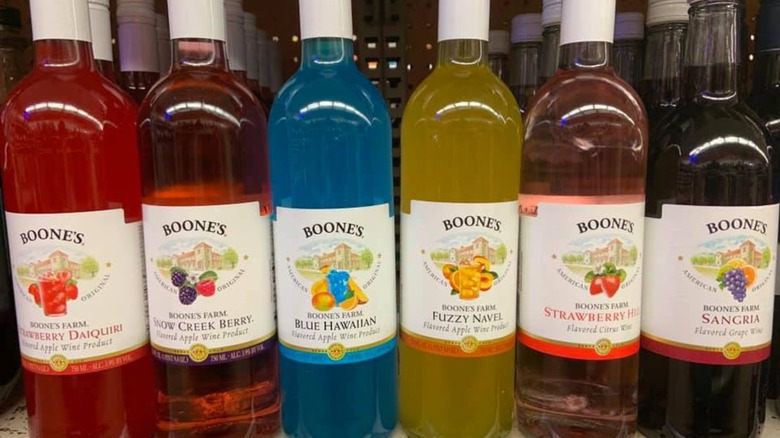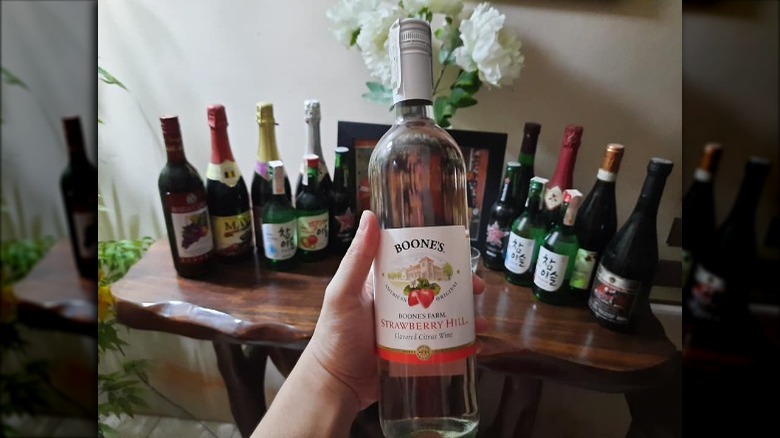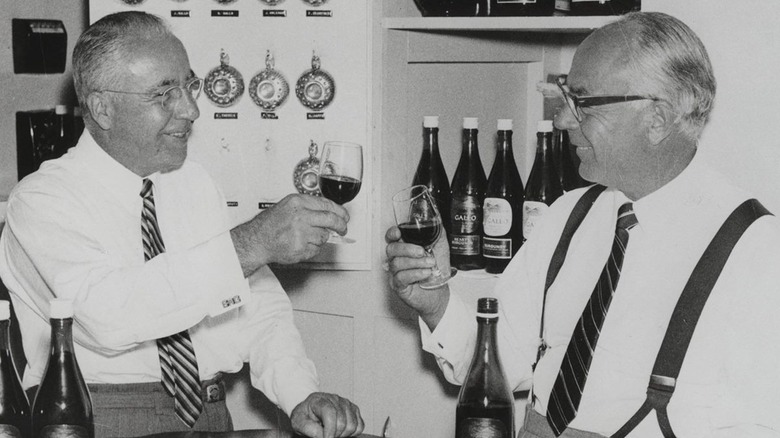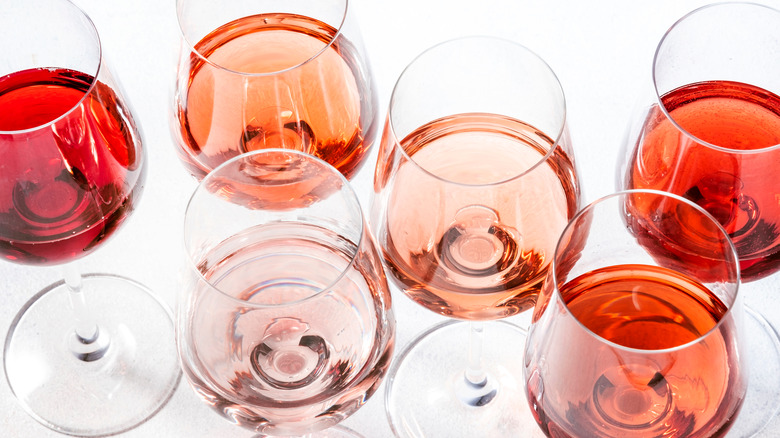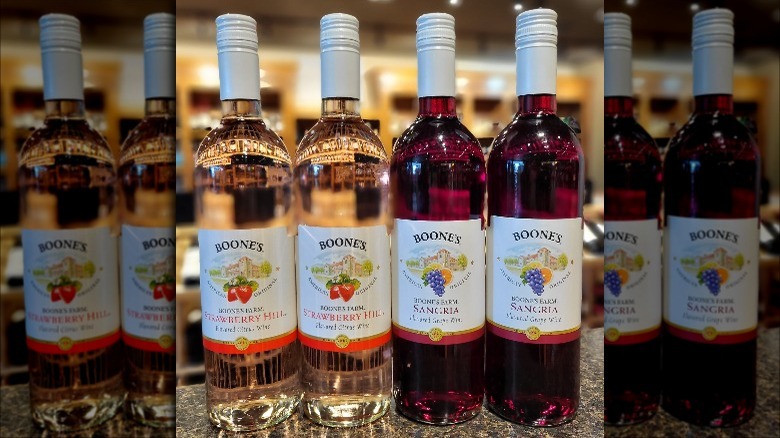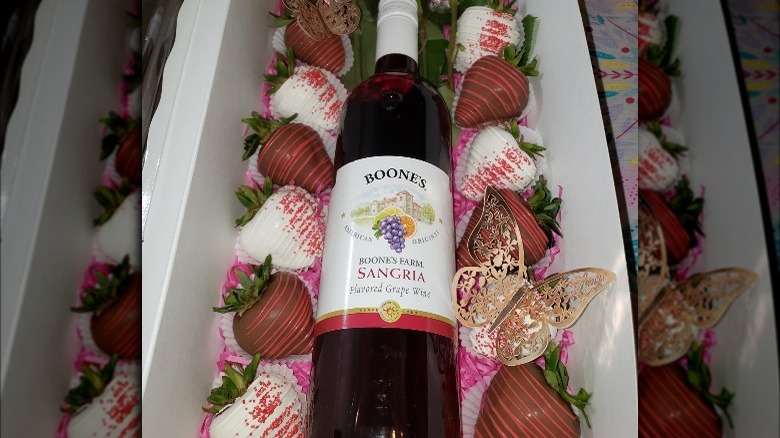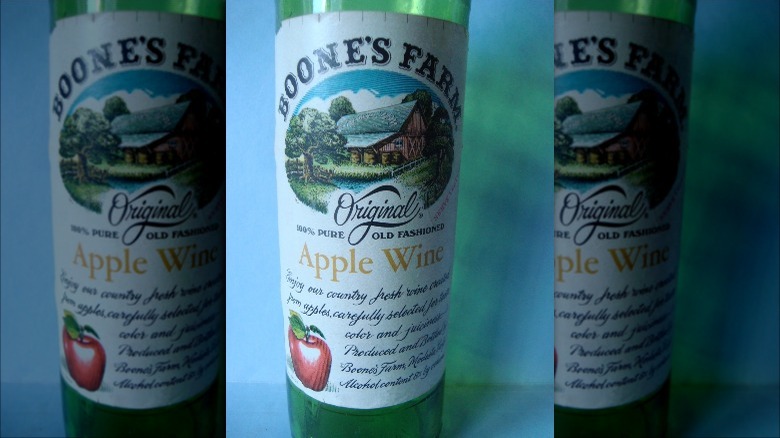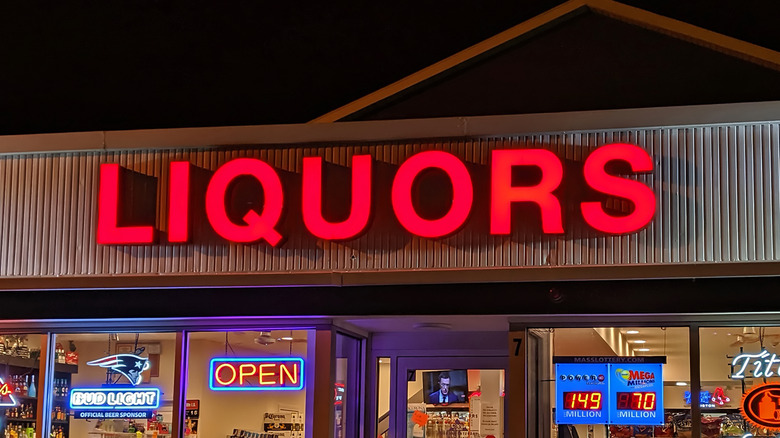The Untold Truth Of Boone's Farm
We may receive a commission on purchases made from links.
If you've ever perused the bottom shelf of your local gas station's wine department, you might have been startled to see an electric blue liquid sitting in a clear bottle with the name Boone's Farm. Now, something that hue sure doesn't look like wine, and you've probably never seen wine come in a Blue Hawaiian flavor before. However, the label proudly states that the bottle contains "apple wine product." Curious, you buy a bottle, bring it home, take a taste, and wonder how something so intensely sweet and downright syrupy could be called wine. But there's way more to this bottle than sugar and food coloring. Little do you know that Prohibition, US tax law, and murder all contributed to putting that bottle on the shelf.
Before Four Loko, Mike's Hard Lemonade, and White Claw began dominating the fruity alcohol market, Boone's Farm went down in many peoples' histories as the instigator of countless sugary, drunken nights. Despite its bright exterior, Boone's Farm hides a rather dramatic story filled with treachery, subterfuge, and crafty business decisions. This is the untold truth behind Boone's Farm.
It's part of the world's largest wine making empire
The maker of Boone's Farm, E. & J. Gallo, is one of the largest wine producers in the world. According to Visit California, the company earns $4.1 billion every year and owns 20,000 acres of California's prime wine-growing land. And the winery is still owned by the family of its two founding brothers, Ernest and Julio Gallo.
The Gallo brothers founded their wine business at the tail end of Prohibition, taking advantage of America's weak supply of domestic vineyards. According to PBS Frontline, Ernest's goal was to build the "Campbell Soup company of the wine industry" by selling ultra-affordable wines. He succeeded by making products that were indeed widely inexpensive and just about universally available. All told, it's easy to see how E. & J. Gallo built its empire by selling strong, cheap alcohol to people on the margins of society, flooding economically disadvantaged neighborhoods with fortified wines like Thunderbird and Night Train.
After almost a century in business, Gallo has diversified its holdings and now owns both premium and budget wine labels. Whether you pick up a bottle from admittedly bottom-shelf brands like Boone's Farm, Barefoot, and Andre or shell out for premium wines like Frei Brothers, Orin Swift, and Columbia, there's a good chance that E. & J. Gallo made the bottle in your cart.
The manufacturer of Boone's Farm is shrouded in scandal
Though the Gallo brothers officially started their business in 1933, the roots of E. & J. Gallo goes back to the vineyards owned by Ernest and Julio's father, Joe Sr. The Los Angeles Times found that Joe Sr. built a winemaking empire during Prohibition. At the time it was legal for families to make up to 200 gallons of wine for personal use, and Joe Gallo's company conveniently provided supplies for people to ferment their own wine at home. But things apparently weren't all well at home, as Joe Sr. apparently killed himself and his wife in 1933, the same year Prohibition was repealed. Although the deceased Gallo's will called for his estate to be split evenly between all three of his surviving sons, Ernest and Julio formed a business partnership that absorbed their father's assets. They subsequently left out their younger brother, Joe Gallo Jr.
In what may have been a weak attempt at appeasing him, Ernest and Julio employed Joe Jr. for a while. Yet they eventually fired him and then sued their brother for using the family name to market a line of cheeses. The Gallo brothers engaged in a vicious decades-long legal battle that concluded with a victory for Ernest and Julio (via Frontline). Throughout the history of the winery, its owners have tried to distance themselves from their Prohibition-era origins and keep the company's dramatic backstory and familial tensions under wraps.
It might not actually be wine
Per Reference, Boone's Farm wines began in 1961 as products made from fermented apples. In fact, the labels on older bottles of the beverage describe the contents as a "100% pure old fashioned apple wine." Over time, the product line expanded to include many different flavored wines and other types of alcoholic beverages. And that's now just for a stylistic reason. The Washington Post reports that, in 1991, Congress raised the tax on wine by a staggering 500%, forcing E. & J. Gallo to reformulate many of their budget wine products to skirt the new taxes.
In reaction to the new law, Boone's Farm switched from being a flavored wine product to a malt beverage. This allowed Gallo to legally classify Boone's as beer so they could pay a lower tax rate. Now, depending on where you are located and which flavor you buy, the Boone's in your bottle could be wine-based or malt-based, according to The Takeout. For instance, the Boone's Red Sangria proclaims to be a flavored grape wine, while its Strawberry Hill is fermented from citrus. And the brightly-hued Blue Hawaiian drink claims that it is really an apple wine product. Given how often the recipe has changed and how secretive the Gallo family is, you never can be sure what you're going to get when you buy Boone's (unless you read the label, of course).
Boone's Farm has a dedicated fanbase
You wouldn't necessarily expect a cheap convenience store brand of wine products to attract a legion of admirers, but Boone's Farm has enough supporters to warrant its own online fansite. There, dedicated Boone's Farm aficionados share testimonials about their booze of choice. Michael from Syracuse says "Nothing goes with sitting naked in the dark watching Golden Girls re-runs on mute while listening to REM's "Everybody Hurts" like six or eight bottles of Boone's." Jason from Indiana reports that "Boone's Farm Snow Creek Berry is a real good buzz, pretty mellow, but you might end up talking to the cops." With those kinds of tongue-in-cheek recommendations, why would you want to drink any other wine?
The site also posts reviews of Boone's flavors using Wine Spectator's well-known 100-point scale. Like the testimonials, the reviews take a satirical tone when it comes to discussing their subject. The review for Fuzzy Navel is a masterpiece of the form, declaring the drink to be "deeply colored and powerful, with a rich, fruity peach aroma and layers of peach, fuzziness, and navel." Sign us up!
Many people drank Boone's as their first alcoholic beverage
The first thing you get drunk on can influence the rest of your time as an imbiber of adult beverages. That is, if you get sick from a certain type of liquor or other booze, those bad associations may mean that you steer clear of that flavor forever. And a generation of young drinkers can thank Boone's Farm for their regrettable early party experiences (via Serious Eats).
Boone's Farm's reputation as fuel for adolescent chicanery is so well-known that it comes with its own slogan: "blame it on the Boone's" (via The Takeout). This saying can be invoked whenever the sugary beverage inspires regrettable decisions or next-day hangovers. And for a long time, Boone's was one of the only drink options for young, budget conscious partiers who didn't enjoy cheap beer.
Despite Boone's Farm's quasi-iconic status as college party fodder, the brand has been eclipsed by other bargain alcohols in recent years. The rise of high-proof malt beverages like Four Loko has pushed Boone's Farm out of the spotlight, and the product is now arguably less widely available than it used to be.
It established the pop wine trend in America
Marc Singer singled out Boone's Farm in his 1972 Esquire essay about America's "pop wine" trend. In previous decades, wine had been a niche luxury product in America. As a result, wine consumption in the US was very low compared to European countries. But then something began to change. United Vintners spokesperson Bruce Johnson credited increased foreign travel and subsequent cultural exchange for bringing wine to the forefront in US markets. This helped to normalize wine drinking for Americans who came of age in the 1970s and beyond. This new generation of drinkers viewed wine as a fun recreational beverage, though perhaps American tastes weren't always quite as refined as those of their European counterparts. American wineries responded by offering a slate of nontraditional wines with sweet and fruity flavor profiles.
Boone's Farm captured more of the emerging "pop wine" market than any other brand. As one liquor store owner remarked to Esquire, "The distinction between [Boone's Farm] Strawberry Hill and strawberry soda pop is not that great." By appealing to the sugar-loving tastes of mid-century Americans, Boone's farm expanded the US wine market and reached out to an audience who may have felt left behind by traditional vineyards and classic wine styles.
It has less alcohol than you might think
MasterClass says that unfortified wines range from under 6% alcohol by volume to a rather boozy 16% (though fortified wines can go up to an eye-crossing 25% ABV). Most vintages hover within a couple of percentage points of 12% ABV. So, with that in mind, Boone's Farm's reputation for giving its fans hangovers and wild ideas would make you think it's on the boozier side of the wine spectrum. However, its ABV actually maxes out under 10% and can even dip under 5%, depending on the flavor. The stronger varieties of Boone's like Strawberry Hill come in at 7.5% alcohol, which is admittedly stronger than most beers, but weaker than the average wine. The weakest flavors like Blue Hawaiian barely have any alcohol in the bottle at all, with a measly 3.2% ABV that's equivalent to some weak beer. You'd have to drink that pretty fast to feel a buzz.
The rowdy image of Boone's Farm probably has more to do with the fact that it was many people's introduction to alcohol, rather than from anything special about the product itself. If you drink Boone's as an adult, chances are good that you'll get a tummy ache from too much sugar long before you get drunk. Still, if you're ever hit by nostalgia or just a craving for both sugar and alcohol, then you probably already know where to look.
